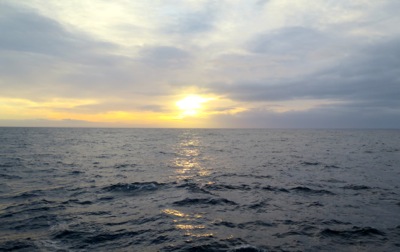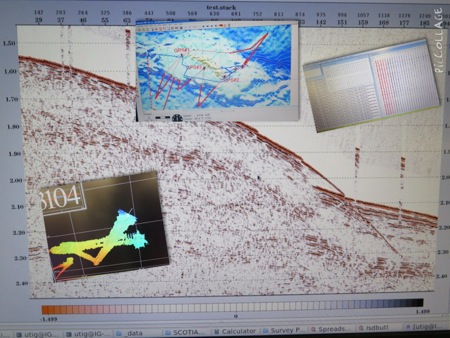Morning everyone, it is another glorious day at sea.
 Another great 4:30 am start to the day, life is good!
Another great 4:30 am start to the day, life is good!
Hip hip hooray, the seas have calmed and at 4:30 this morning the crew was out and about, the scientists were out and about, and the seismic is now in the water.
 Thirty minutes after first light, and clear of marine mammals, the seismic umbilical goes in off the back deck.
Thirty minutes after first light, and clear of marine mammals, the seismic umbilical goes in off the back deck.
For well over an hour, lines were checked, connections secured, and two towed devices were deployed off the back deck of the Palmer. If you look back to yesterday's entry there were specifics for the gun umbilical and the streamer, both of which are currently being towed behind the vessel.
 Once the umbilical is in the water, next comes the streamer, 72 hydrophones are in the water.
Once the umbilical is in the water, next comes the streamer, 72 hydrophones are in the water.
The team has now moved inside to use our computers and very specific programing to record the data collected by the streamer, and then to decode.
 Raw data coming in from the seismic instruments. One part instruments in the field, five parts decoding the data collected.
Raw data coming in from the seismic instruments. One part instruments in the field, five parts decoding the data collected.
Let's review: we are looking for original crust, which is under sediment. This crust, or 'basement' as it is called in geologic circles, is +/- 130 million years old. We are at a depth of over 4000 meters (almost 2500 miles).
The South Georgia micro continent is moving east away from South America, while South America is still moving west. Maybe a picture would help.
 The South Georgia Plate. Plate tectonics 101: two plates moving in opposite directions make for some great science.
The South Georgia Plate. Plate tectonics 101: two plates moving in opposite directions make for some great science.
Please notice that the South American Plate is broken by the Scotia Plate with both are moving in opposite directions, with the Scotia Plate moving to the East, and the South American Plate moving to the West. So what does this mean? Pressure. The movement of land masses and the opening to the ACC (more to follow on the ACC).
Scientists are filling in bits of geologic history as it pertains to the South Georgia Plate and its role in the history of plate movement in this region. Often there are days when my head is spinning with the "historical" geology I am learning. Up until this afternoon I had forgotten that there are seven major plates: North American, South American, Antarctic, African, Eurasian, Pacific, and Indo-Australian, with 20 plus or minus platelets covering the planet. Today was a great day of learning for everyone.
 Steffen Saustrup teaching UTIC students and me about the real-time data being collected by the seismic streamer.
Steffen Saustrup teaching UTIC students and me about the real-time data being collected by the seismic streamer.
Thank you to everyone who helped with today's flag pictures. It was an amazing lunch and we wanted to share with all you flag followers. See everyone tomorrow.
 Everyone at lunch got in on the flag action. It was also a great meal!
Everyone at lunch got in on the flag action. It was also a great meal!
 Every time I get the crew and science party involved with flags, I feel a sense of pride in knowing that we have shared this amazing research with so many!
Every time I get the crew and science party involved with flags, I feel a sense of pride in knowing that we have shared this amazing research with so many!

Comments
Pagination